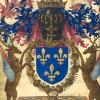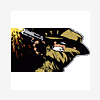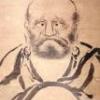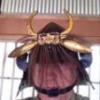Leaderboard
Popular Content
Showing content with the highest reputation on 09/14/2024 in all areas
-
4 points
-
4 points
-
The left side should be 住吉太神宮奉以剱余鉄 Made with steel left over from the making/dedication of a sword for Sumiyoshi Taisha (shrine).4 points
-
3 points
-
3 points
-
The bottom six characters on the right might be [奉拜?]摂刕一宮 = [on a visit to?] Sesshū Ichinomiya3 points
-
Nice sword and nice Naotane mei. Isn`t it.. https://www.touken-m...duct/shousai/KA-05992 points
-
Dear all I am looking for reference material on F/K by Nara Toshinaga which do either show monkeys/eagles or which are signed on the right side of the fuchi. Let me explain the background of my somehow strange request. I have in my collection a wakizashi koshirae which has formerly been owned by the now closed Tosogu Museum in Tokyo (sold via Christies in the early 2000s). The koshirae has undergone a restoration in the second half of the 20th century. As part of this restoration process, a new saya was made, the original menuki were removed AND the fuchi/kashira WERE REPATINATED. As a result, they look rather new but could in fact be much older. As the fuchi is signed "Toshinaga Kao" and we all know that his mei was very often faked, I had dismissed them as gimei ever since the koshirae came into my possession. I still consider the mei to be at least critical BUT after studying the workmanship for a while I must say that they are really well done. In particular, the ishime ground is very appealing (I tried to focus on this feature in my pictures). The easiest way would of course be to submit them for shinsa. However, the NBTHK has become very hesitant in the last year and when it comes to one of the big names, I guess that my best result could be horyu. And that does not help me at all. That means that I have to trust my own (and maybe your) judgement and would be gratefull for reference material on F/K by Toshinaga (ideally from the book on the Nara San Saku). Kind regards and a big thanks Chris2 points
-
2 points
-
2 points
-
That is called deceitful. If you sell something and you know for a fact that it's gimei, or not made in Japan, and you don't mention that claiming "the buyer should know what he's buying" then you are being deceitful. Let's not make excuses for these guys.2 points
-
2 points
-
I think that the first one is also Christian iconography. The kuruma is pretty specific as a symbol of the spiritual path. The most common image has 8 spokes to denote the eight-fold path that traces back to the ancient origins of buddhism from the time of Gautama Siddhartha. Here are a kuruma (Ohno) and an image of Buddha with sun and stars (Kanayama).2 points
-
Nothing experienced here, and no outage reports, so I can only assume it's something to do with the underseas cables to overseas again. Am sure it will resolve itself in a day or 2, as it isn't a server problem. But keep me updated and I'll investigate this side. If you can post times when you have had issues, and what time it is better (if it is) that would help. Also if you open a command prompt and type: ping www.militaria.co.za and post the times taken for the packets, and if there is data loss, I can investigate. Even better, visit https://gsuite.tools/traceroute and connect to www.militaria.co.za and hopefully we can see where the delays are in the routing.2 points
-
You're welcome. Just remember that Shintetsu is never a positive trait, even when it is a kantei trait (e.g., Aoe, Rai). However, when it is a common trait, it is least likely to detract from the overall appraisal of the blade because it is to some degree expected. The same logic applies for Ware, which is common for Hosho, or Nagare elements which are common in Kamakura Soshu works. Such traits would be considered a significant problem in a blade by Osafune Kagemitsu for example, where consistency in the Jigane is considered the smith's forte and a major point of appreciation. The rule of thumb: "If the smith/school is known for certain traits, either positive or negative, ensure that the blade exemplifies the positive, and rest assured that the negative will not detract"2 points
-
2 points
-
神力丸有續作之 = Jinrikumaru Aritsugu made this Markus Sesko's Swordsmiths of Japan has the following entry: I can't decipher all of the writing on the other side, but it starts with: 天下太平 = peace and tranquility for the whole world 武運長久 = long-lasting good luck in war2 points
-
Josh My thoughts are: If you plan on selling it (i think that is what you want to do) no not have any restoration done, Oil it and care for it as Grey suggested. If you have the handle re-wrapped it will cost you money/time and a buyer may not like the results. Research it (you are doing that now) get all the info you can. Then sell it once you know what you have. You are in Seattle, did anyone suggest you show it to Brian T? He is a known person and is knowledgeable and is local to you. I think the more people who see it offers the opportunity to learn and you get multiple opinions/offers. If you have the journal and picture this may bring the best price to a militaria collector but you will figure that out as you go. Smart to move slowly. Just my opinion Mark2 points
-
Surprise addendum: On a lark, I sent the tsuba back to Japan for a second opinion from NTHK. Just heard that they’ve papered it!2 points
-
Quite a nice, simple to digest, overview of the Japanese Tatara process and an account of the history. Seems the process of smelting various iron containing raw materials to create high quality steel began in the Middle East and the technology moved East and West, through China and Korea in the case of the former. Japan started to produce its own steel for tools and swords in the 6-7th centuries. https://www.Japan-in...JapaneseBlade_01.pdf2 points
-
Hi All, Just got this Shin gunto in a black leather covered saya, Non pierced tsuba, full set of 8 seppa all with the number 25 stamped on them plus another small inspection stamp. The nakago is signed (I think) Shimada Yoshisuke. No Seki or Showa stamps The only stamp it has is a warrior stamp. For interest, Here is the Signature Hamon And finally tsuba and seppa stamps All the best2 points
-
2 points
-
Hello everyone, Sunobi Tanto signed Echizen Kuni Shimosaka Sadatsugu Sadatsugu Shimosaka Early Edo – Echizen Province – 1624 Shimosaka School NBTHK Tokubetsu Hozon certificate Fujishiro rank : Josaku Flawless and beautiful ubu blade, one mekugi ana. Koshirae richly decorated with solid gold menuki. Nagasa: 30.5 cm Sori: 0.2 cm Moto-haba: 2.8 cm Moto-kasane: 0.5 cm Don't hesitate to visit my website for more information and pictures. If sold through the NMB, I will make a donation. My price : 7800 € (+ shipping)1 point
-
Dear Gentlemen, this excellent tsuba from my former collection is for sale. I acquired this tsuba many many years ago from a well-known collector in the USA and am offering it for sale here. As it will be extremely difficult to attribute it to a particular lineage or school, individual collector speculations and attributions are extremely difficult. An excellent tsuba in absolutely flawless and wonderful condition! An absolute highlight for any serious tsuba collector! The iron, the texture, and its size correspond to the famous early Owari - Kanayama.... a piece that could correspond to this tradition. Another option is the early Myochin school, which, however, did not leave many early tsuba known to us for comparison. The Myochin are better known to have specialized more in the production of armor parts and helmets so far. The dimensions of the tsuba are: 75 x 75 mm diameter - 6 mm thick on the seppa-dai and 11 mm thick on the mimi. The tsuba has not yet been presented and therefore comes without papers. My asking price is 2800.- Euro Please only serious inquiries Tsuba is in Germany Thank you very much! A Donation to the board will be done if sold here. Cheers! Chris1 point
-
Looks like a surname 大野 (Ohno, or Ōno). The bit under those two would be the given name, but I can't make it out.1 point
-
1 point
-
Almost certainly not koto? Its shinto period's Kanemoto style, maybe by his lineage, maybe by one of many imitators. But it still might paper to later generation Kanemoto.1 point
-
BIG thanks to everyone who helped. I think i understand the inscription. Again sorry about the pictures.1 point
-
Really cool to see the matching number painted on the saya liner! Great sword, Adam!1 point
-
Coming up, but first, that small stamp on your seppa is the Nakano Shoten logo. "Located in Tokyo, this comany was owned by Mr. Nakano. In additon to Tokyo, the company had shops in China. The company provided a full range of koshirae."1 point
-
1 point
-
I have 4 other Yoshisuke blades with the stamp and 1 Yoshichika, noted by Thomas above. None are dated. 3 are in kaigunto fittings, the other 2 in Type 98.1 point
-
The Ohno kuruma tsuba thread was started by me in August 2024. I agree with quite a few observations by Jake and others about the appearance of buddhist and christian iconography on sword fittings during the Momoyama and Early Edo Periods of particular interest to me. Zen buddhist iconography in the explicit forms of the kuruma, manjimon, amida-yasuri, and others was fairly common. I think it’s important that the context of the tsuba for the buke be kept in mind. It had an essential functional role as a guard, but the motifs were also of spiritual value (I mean this as an overarching theme) for a warrior class engaged in battle to the death. The buddhist motifs would easily allow for the borrowing of Jesuit/Catholic iconography in place of, for example, the preexisting amida-yasuri motif for spiritual inspiration among the buke. The common reference to the “clock gear” tokei motif is plain wrong. As advanced in “Owari To Mikawa No Tanko,” it is actually a Jesuit/Catholic symbol introduced by the Portuguese as pointed out earlier on this thread. Why the heck would buke want a “clock gear” on their blood stained katana? Where is the spiritual meaning? Maybe merchant dandies would later commission tokei for their katana as status symbol bling, but not the buke during the late 16th and early 17th centuries. Death was a serious business…1 point
-
Speaking as someone with an education in the IT field - Large language models like ChatGPT are getting more accurate every day, but I firmly place them within a rule as old as the internet: Do not take serious medical or academic advice from an online generated source, chatGPT and its like should be treated as a fancy version of wikipedia, nothing more.1 point
-
1 point
-
1 point
-
Here's a sad one for you, John! Mumei blade, sale by Centurion Auctions HERE.1 point
-
You can also include Aoe where Shintetsu is a kantei feature, thanks to the thin Kawagane. In Koto blades the Shingane can be of a high enough quality to have features that might be expected in the jihada.1 point
-
First and foremost, thank you very much for such an insightful post. I found it very helpful. I did have one question about the section on jigane, in particular shintetsu. Is this tolerance of shintetsu an overarching thing - that is, applicable to all blades generally - or is it more particular to blades from schools like Hizen or Rai, in which I understand it may be a bit of a kantei point? (If I'm incorrect on that issue my apologies, I'm a rather rank beginner at all of this.)1 point
-
SOLD. NMB contribution once I get it mailed.1 point
-
I’m looking forward to this one! Thanks for the sale Chris, a very interesting piece!1 point
-
I have my doubts, it will boil down to the classic garbage in, garbage out scenario. The problem that may come around is that the water gets so muddied that it's no longer possible to rely on internet-based research as no-one knows what sources are trustworthy or that it becomes accepted as reliable because, well it's the internet isn't it. We are cursed with living in interesting times.1 point
-
Tadahiro is a good example because they are plentiful and similar. It's the closest we have to a commodity in the Nihonto sphere. This lets us compare different attributes and think more deeply about price determinants. Tadahiro_1: 1M yen Tadahiro_2: 2M yen Tadahiro_3: 3M yen For most in the West, Tadahiro_2>Tadahiro_3>Tadahiro_1. Why? It's an excellent example because it illustrates some of the difference between Western appraisal of value and Japanese appraisal of value. Koshirae: West > Japan In the West, having a koshirae is highly valued. It's known to Japanese dealers, hence they'll adapt low quality koshirae to sell blades to the western markets. In Japan, sword collectors typically do not care. These are seen as two separate objects, and they appeal to distinctly different collectors types. It's a completely different world in terms of knowledge. Jigane consistency: West > Japan Western buyers are highly sensitive to minute defects in the jigane such as ware, showing of shintetsu, or irregularities (nagare elements). Much less so in Japan. In fact, if one carefully studies the elite blades (Tokuju/Jubi/Jubun/Kokuho), these types of defect are often present, even in the highest ranking smiths. Jigane consistency is not to be confused with brilliance/wetness (Uroi). The uroi quality of the jigane is a highly valued attribute in Japan, even in the presence of nagare elements or ware disturbing the consistency of the jigane. Brightness of the Hamon: Japan > West The attribute of "bright and clear" or Saeru is the most important attribute of a sword in Japan. This manifests as clarity in the Jiba, the contrast between the ha and the ji, and the overall consistency of the nioiguchi, a ha free of blemish (Shimi), and overall distribution, type and variety of nie. These are paramount qualities. There are differences between schools in how these qualities are appraised (e.g., Soshu vs Bizen), but these are advanced topics best left for another discussion. Now go back to the 3 Tadahiro and look at the hamon photos. Tadahiro_1: suffers from a grave flaw on a suguha blade: inconsistent nioiguchi. There is an area where the nioiguchi expands upwards and downwards, this is considered a lack of control by the smith and disqualifies the blade as a good sword. This explains the price, it is simply a bad example of Tadahiro. Mistakes happens. Tadahiro_2: the nioiguchi is rather consistent. Check. However, the contrast between the ha and the ji is not pronounced. Hence, it is not 'bright and clear' - rather, the noiguchi line is and the hamon is rather unremarkable. The Jigane is consistent everywhere, and it has a koshirae and a horimono. This appeals to the western market, but is very weak in the Japanese market. Tadahiro_3: the nioiguchi is deep and consistent. The ko-nie laden nioiguchi creates a bright contrast with the ji, and extends downwards towards the ha. There are kinsuji forming into the ko-nie, another sign of a good sword. These attributes are highly valued and constitute the essence of a masterfully crafted sword. Now, there is shintetsu showing. Big problem in the West, not so much in Japan. For these reasons, Tadahiro_3 > Tadahiro_2 > Tadahiro_1 - and while this hierarchy will be quite obvious to any intermediate student in Japan, it's puzzling for us in the West simply because we value attributes differently. For the sake of simplicity I'm leaving out other attributes (Motohaba, Sori, Nakago condition). These attributes are overshadowed anyway by the stark contrast in the Jiba of these works.1 point
-
@Jussi Ekholm, your Tadahiro comparison is certainly interesting, precisely because we have a noticeable price difference here from one and the same swordsmith. You base your choice on the fact that price is not important. But it would be interesting not to do so, precisely in the spirit of the topic. Your choice is understandable. The blade is relatively well preserved, it has Horimono and it has a Koshirae. These are all factors that make such a sword very attractive to collectors on the general market. But it is priced exactly in the middle. So why isn't the most expensive Tadahiro in your comparison with such high market potential? Is it just because of the cut test of a well-known representative with a good, fairly early date? The appearance of the sword is marred by the fact that it has already lost some material. In some places the thin Hizen-Kawagane appears to have been polished through. In addition, the blade is machiokuri and the original Nakago-Jiri was cut off. Nevertheless, I think that this sword is the best of the trio in terms of quality. Although my opinion is irrelevant, I would go so far as to say: if this blade were in the best condition and Ubu, with the cutting test as a bonus - this sword would be a Juyo candidate! (Jussi, you know more about this, but I seem to remember that Nidai Tadahiro is the Shinto smith with the highest number of Juyo). But since this is not the case, it requires a collector who is willing to pay the price and is willing to accept the "problems". However, in the price range you have presented, Tadahiro katana with TH are very common. Collectors who are specifically looking for a Tadahiro have a choice and can set certain parameters, such as the time the blade was created, the shape and length, the characteristics of its signature and ultimately its style, which also includes gunome and choji. Your Tadahiro example in particular shows that the topic of prices and swords is not so simple and that you often have to look at each individual case. If the old guard continues to disappear, an era is certainly over. I don't have enough insight into the scene, especially in Japan. But I have the feeling that a certain elitist and hierarchical thinking was not beneficial in past decades. It is so important that students surpass their masters. Only then has the master done everything right. And only then will new, strong generations emerge. I emphasize again that I have too little background knowledge on the subject and I can only rely on my gut feeling. Old names are disappearing. Submitting kodogu and blades to a Shinsa of the NBTHK has become more difficult due to limitations and tight registration windows. The last Juyo sessions were the strictest in history. The positive thing, however, is that it counteracts the previous paper inflation. Yes, more young people in Japan seem to be developing an interest in Nihonto, also triggered by various anime and manga. At the same time, more and more museums in Japan are experiencing financial problems. The number of registered swordsmiths is also decreasing. There are discussions in Japan about whether the traditional training of apprentices in the swordsmith's home is still appropriate... Internationally, too, one must not forget that certain political activism and tightening of national gun laws are making it increasingly difficult for collectors in some countries to pursue their hobby. I would really like to be optimistic, but to be honest, I am anything but sure in which direction things will go in the future...1 point
-
Shinsa is also not free of charge, so I guess it's not objective either.1 point
-
Looking for older than that. My goal is to eventually get a kamakura/heiean tachi and have it mounted in period correct koshirae the way it would have been when it was made.1 point
-
Over the years I have posted things and subsequently forgotten them, so now I need to go back and read everything again, which tsuba I have posted, and all the arguments for and against! One thing is for sure, though, it seems that you cannot talk openly about Christianity even today in Japan, unless it is at some specialist convention or scholarly meeting. I have noticed that people will try to avoid talking about it, like it's anti-magnetic, or they will subconsciously drop their voices as if they are somehow afraid of being overheard. Of course it is possible that Japanese people think I might be a Christian and they don't want to encourage me to start talking.(?) For this reason I have on occasion explained that although I come from a Christian background, I have done yoga and Buddhism, and we had a Shinto marriage, so I am not in the business of pushing the forms of religion in any direction. Here’s a fairly recent arrival.1 point
-
3 NMB pages of multiple discussions about Komonjo here.1 point
-
Buyer beware with that seller, many of the items have likely failed Shinsa in Japan and are now being peddled to a less educated market.1 point
This leaderboard is set to Johannesburg/GMT+02:00


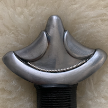















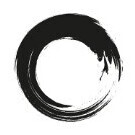


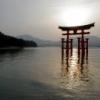


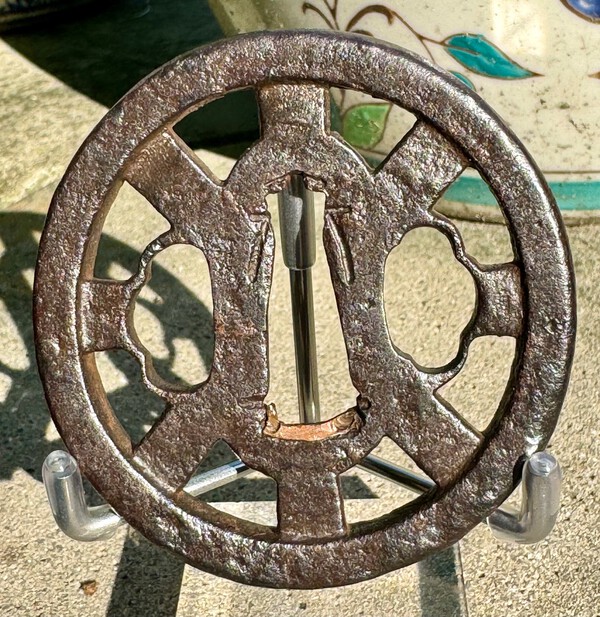











.thumb.jpg.31dee31de5f9213649f16878683d668f.jpg)
.thumb.jpg.fef2e03f9e8228225746f44f79d85ba9.jpg)
.thumb.jpg.39fe2ba36fcf0b09c9b9e9e7152e7862.jpg)
.thumb.jpg.2ba5dd45e2c4ac94a8d91b6d14e82ed9.jpg)
.thumb.jpg.ca61139a4d496c4eae0762db10e23860.jpg)
.thumb.jpg.0e194d1608e1089f5f6f2f33e46ca7fd.jpg)
.thumb.jpg.75c24d49de7ce391fd47a565800106c4.jpg)
